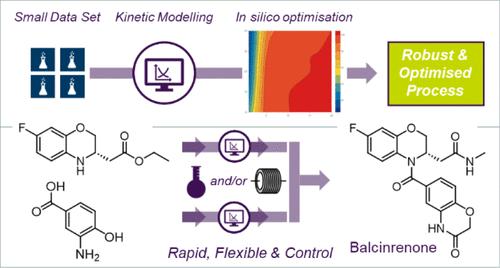通过动力学建模加强工艺开发的历程:生产巴辛酮的高效路线
IF 3.1
3区 化学
Q2 CHEMISTRY, APPLIED
引用次数: 0
摘要
这项工作的重点是加速开发一种多功能工艺,用于合成活性药物成分巴新烯酮途中的一种关键酰胺中间体。在开发的早期阶段采用预测动力学模型促进了工艺的开发。预测动力学模型有效地指导并加快了在甲醇中使用甲胺进行伸缩不对称还原/酰胺化工艺的批量和连续生产的路线设计、工艺设计和工艺优化。伸缩批量工艺的实施显著提高了合成巴辛烯酮的产量、可持续性和经济效益,并成功制造出了关键的酰胺中间体。此外,利用多线性回归(MLR)- 动力学混合模型,快速开发出了一种使用水中甲胺的替代工艺,为甲醇中甲胺短缺时的生产活动提供了应急计划。除主要重点外,本研究还扩大了动力学建模的应用范围,以指导通过 pH 值控制的加成/环化获得的第二种中间体的工艺设计和优化,从而提高了对这一步骤的理解和产量。最后,通过使用结构化实验设计(包括初始动力学研究),发现了生产丁二酮的最终酰胺键形成的改进条件。本文章由计算机程序翻译,如有差异,请以英文原文为准。

A Journey through Process Development Enhanced by Kinetic Modeling: An Efficient Manufacturing Route to Balcinrenone
This work focuses on the accelerated development of a versatile process for synthesizing a key amide intermediate en route to the active pharmaceutical ingredient balcinrenone. The process development was facilitated by the implementation of predictive kinetic models at the early stages of development. The predictive kinetic models effectively guided and expedited route design, process design, and process optimization for both batch and continuous manufacturing of a telescoped asymmetric reduction/amidation process using methylamine in methanol. The implementation of the telescoped batch process led to significant enhancements in throughput, sustainability, and economic efficiency of the synthesis of balcinrenone, resulting in the successful manufacture of the key amide intermediate. Additionally, the utilization of a multilinear regression (MLR)-Kinetics hybrid model enabled the rapid development of an alternative process using methylamine in water, providing a contingency plan for manufacturing campaigns in the event of shortage of methylamine in methanol. In addition to the primary focus, this study expanded the application of kinetic modeling to guide process design and optimization for a second intermediate obtained via pH-controlled addition/cyclization, thereby enhancing understanding and throughput for this step. Finally, the use of a structured experimentation design involving initial kinetic studies led to the discovery of improved conditions for the final amide bond formation to produce balcinrenone.
求助全文
通过发布文献求助,成功后即可免费获取论文全文。
去求助
来源期刊
CiteScore
6.90
自引率
14.70%
发文量
251
审稿时长
2 months
期刊介绍:
The journal Organic Process Research & Development serves as a communication tool between industrial chemists and chemists working in universities and research institutes. As such, it reports original work from the broad field of industrial process chemistry but also presents academic results that are relevant, or potentially relevant, to industrial applications. Process chemistry is the science that enables the safe, environmentally benign and ultimately economical manufacturing of organic compounds that are required in larger amounts to help address the needs of society. Consequently, the Journal encompasses every aspect of organic chemistry, including all aspects of catalysis, synthetic methodology development and synthetic strategy exploration, but also includes aspects from analytical and solid-state chemistry and chemical engineering, such as work-up tools,process safety, or flow-chemistry. The goal of development and optimization of chemical reactions and processes is their transfer to a larger scale; original work describing such studies and the actual implementation on scale is highly relevant to the journal. However, studies on new developments from either industry, research institutes or academia that have not yet been demonstrated on scale, but where an industrial utility can be expected and where the study has addressed important prerequisites for a scale-up and has given confidence into the reliability and practicality of the chemistry, also serve the mission of OPR&D as a communication tool between the different contributors to the field.

 求助内容:
求助内容: 应助结果提醒方式:
应助结果提醒方式:


